#iranian graphic design
Explore tagged Tumblr posts
Text

#graphic designe#illustration#shahab tondar#chahab#analog#research#iranian graphic design#persian graphic designer
6 notes
·
View notes
Text
Casual analysis of graphic design and composition (ft. a bit of colour theory) since I’m a bit rusty and haven’t thought about them in a while
Hm? Some shots in Al-Haitham’s and Kaveh’s demos share a similar composition…
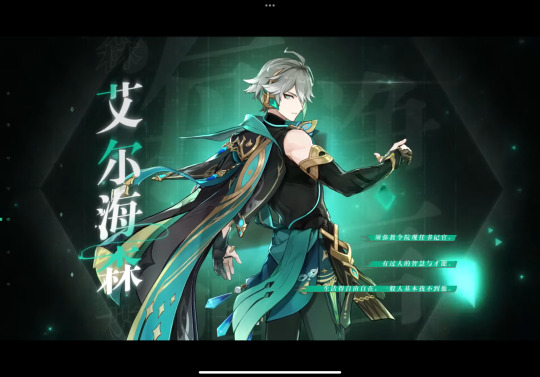

But it’s interesting that the more logical one uses informal symmetry in his character title card and the more emotional one uses formal symmetry… So many rectangles in Kaveh’s card (‘course it helps that hanzi characters are in squares)… It’s kinda surprising, but still it brings out the flow of the illustration well. (Of course, Chinese hanzi can be read horizontally or vertically, so they’ve more freedom in typography, but I bet they changed the graphic layout a bit for the English demo…)
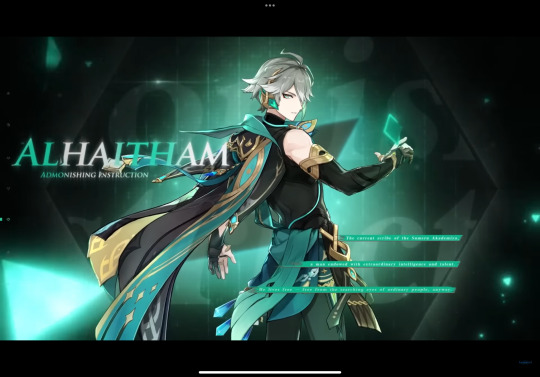
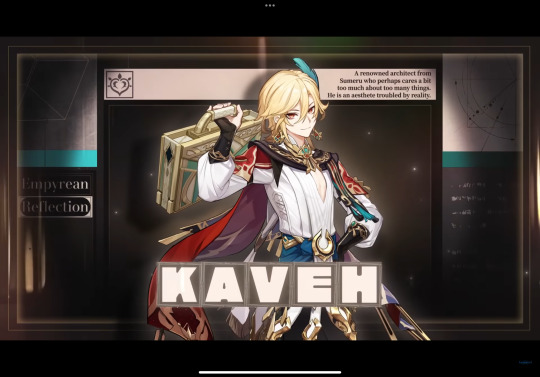
hah, yeah, I thought so. See how Kaveh’s cape can’t frame the center boxes anymore, and how there’s no space to the right of the synopsis in the upper right, and most of all how the two squares on the bottom left is now a quarter of the original size, leaving an empty space there (though if they rotated the words vertically it could fit into the rectangular space well).
Al-Haitham’s English title card isn’t bad, per se, but they could’ve put some shadow on the left side of the illustration so the text could stand out, and move the three green lines to the right side a bit more, so not everything is slightly to the left side when there’s no reason to. (The negative space on the two sides in the Chinese version is roughly the same size.)


These two shots are both long shots that show the character’s full body, but Al-Haitham is in a slightly low angle, and Kaveh is eye-level with the “camera”
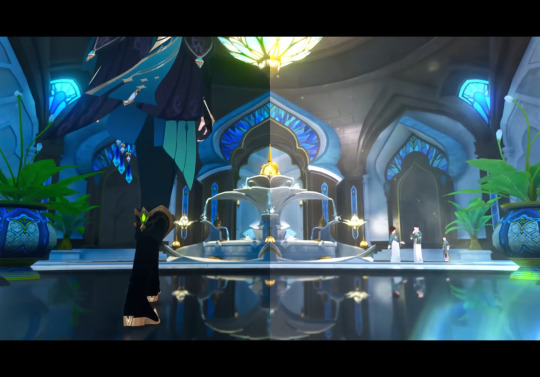
This one’s another low angle full shot with Al-Haitham’s lower body, with a bunch of analogous colours. Also this one’s background uses formal symmetry again (even reflecting off the ground) while the placement of the characters are in informal symmetry (the large image of Al-Haitham balances out the small figures near the fountain)
#procrastinating… on syntax assignment#Al-Haitham would probably tell me to go finish it#but. if their models have dark skin#to reflect their inspirations#of the Arab mathematician and physicist al-Haytham#and Iranian mythological figure Kaveh the Blacksmith#then their title cards have to use different colours since the official colour scheme#(the value contrast) in the demos ride on the fact that the characters are pale-skinned#in other words#the illusts stand out against the dark background because the characters are pale-skinned#dusk analysis#Genshin impact#kaveh#genshin kaveh#composition#art composition#graphic design#al haitham#al-haitham#alhaitham#genshin alhaitham#genshin analysis#long post
45 notes
·
View notes
Text

Sadegh Hedayat ::: The Blind Owl
2 notes
·
View notes
Text

The SR-71 crew who training in anti-SAM tactics left a 5-mile-long contrail in the stratosphere after dumping fuel for 10 seconds to see if the afterburner would ignite the fuel trail
The Blackbird
The SR-71, unofficially known as the “Blackbird,” is a long-range, advanced, strategic reconnaissance aircraft developed from the Lockheed A-12 and YF-12A aircraft. The first flight of an SR-71 took place on Dec. 22, 1964, and the first SR-71 to enter service was delivered to the 4200th (later 9th) Strategic Reconnaissance Wing at Beale Air Force Base, Calif., in January 1966. The U.S. Air Force retired its fleet of SR-71s on Jan. 26, 1990.

CLICK HERE to see The Aviation Geek Club contributor Linda Sheffield’s T-shirt designs! Linda has a personal relationship with the SR-71 because her father Butch Sheffield flew the Blackbird from test flight in 1965 until 1973. Butch’s Granddaughter’s Lisa Burroughs and Susan Miller are graphic designers. They designed most of the merchandise that is for sale on Threadless. A percentage of the profits go to Flight Test Museum at Edwards Air Force Base. This nonprofit charity is personal to the Sheffield family because they are raising money to house SR-71, #955. This was the first Blackbird that Butch Sheffield flew on Oct. 4, 1965.
During its operational lifetime, the SR-71 provided intelligence about the Yom Kippur War in 1973, the Israeli invasion of Lebanon in 1982, the US raid on Libya in 1986 and the revelation of Iranian Silkworm missile batteries in 1987. The USAF ceased SR-71 operations in January 1990.
Throughout its nearly 24-year career, the SR-71 remained the world’s fastest and highest-flying operational aircraft. From 80,000 feet, it could survey 100,000 square miles of Earth’s surface per hour.
SR-71 crews anti-SAM tactics
In 1968 the SR-71 crewmembers spent most of their time in the crew lounge, discussing anti-SAM tactics.
As told by Paul Crickmore in his book SR-71 Blackbird (Combat Legends), as the 9th Strategic Reconnaissance Wing approached the time when they would be flying out of the country at Kadena Air Base, Okinawa.
The SR-71 crew who training in anti-SAM tactics left a 5-mile-long contrail in the stratosphere after dumping fuel for 10 seconds to see if the afterburner would ignite the fuel trail

This print is available in multiple sizes from AircraftProfilePrints.com – CLICK HERE TO GET YOURS. Dawn at 80.000ft – SR-71 Blackbird
The plan was to penetrate enemy airspace at Mach 3. If fired upon, the pilot would accelerate to Mach 3.2 and climb, thereby forcing the missile’s guiding system to re-calculate the intercept solution. One idea was also to dump fuel to become lighter, thereby increasing the climb rate.
A 5-mile-long contrail in the stratosphere
A crew ended that debate during a Sortie over Montana by dumping fuel for 10 seconds to see if the afterburner would ignite the fuel trail. Instead, this turned instantly into an ice cloud in the fridge -55° C stratosphere and left a 5-mile-long contrail finger pointing directly at the aircraft.
The pilot reported that he could see the trail for hundreds of miles after turning back towards the west. That plan was scratched. That was the opposite effect, but they wanted regardless, the SR-71 was the first attempt at stealth in an airplane.
Be sure to check out Linda Sheffield Miller (Col Richard (Butch) Sheffield’s daughter, Col. Sheffield was an SR-71 Reconnaissance Systems Officer) Twitter X Page Habubrats SR-71, Instagram Page SR71Habubrats and Facebook Page Born into the Wilde Blue Yonder Habubrats for awesome Blackbird’s photos and stories.
@Habubrats71 via X
27 notes
·
View notes
Text
I know i say "wear a mask and riot" and "fuck a peaceful protest" but I'd had a nice long post about how digital work and advocacy is praxis (or can be) on my old account. Right now, COVID is spreading and killing thousands of people in the US alone and nearly all """radicals""""" and """""leftists"""" are philosophically no different than the fascists they claim to oppose because they are so thoroughly wedded to eugenics that they refuse to wear and enforce masking. COVID causes long COVID in 10-30% of cases so the so-called US alone may well be a majority disabled nation now due to rampant eugenics forcing the spread of COVID. Long COVID is a rotting death and makes everything an order of magnitude more difficult if you still are able to do the things you were prior. Repeated COVID infections means you're guaranteed to be immunocompromised permanently and disabled in other ways you'll likely find out the hard way. With 40% of cases being asymptomatic and most only showing severe symptoms after 2-3 infections, and many starting to drop dead after 3 to 5 infections, many people accrue damage from and spread COVID without realizing it until it is far, far too late. As a result, it's guaranteed that the ableists have disabled and killed people. They've kept disabled people like me who are high risk out of radical spaces & communities. They've abandoned solidarity for everyone but the abled, ableist middle class while focusing most of their efforts on electoralism, despite the clear and constant failures of such actions. The BLM Rebellion of 2020-2021 had significant---albeit broadly temporary--impacts on electoral politics, society, and communities because it was a constant and ongoing rebellion that was also much more disability inclusive than prior leftist movement moments. For the first time, people recognized the need for remote actions & support because while masking was at the high water mark, more abled people understood that a lot of us disabled could not and would not risk COVID but we had had skills vital to the project. Things disabled people were absolutely critical for during the BLM Rebellion: police scanner observation and transcription, evacuation coordination, event & route planning, translation services, postering, graphics art & design, self defense seminars, radio nets, mutual aid fundraising, mutual aid distribution, bail fund coordination, zine writing, mask & test distributions, contact tracing (remember this??!??!), car brigades, organizing medical supplies, teaching first aid skills, and countless other roles often organized & performed remotely. For every fighter, there are at least a dozen support roles and with some thought and effort, those roles can be aided or done digitally. Posting on its own can be praxis in that it shares information, knowledge, tactics, demonstrates that there are other radicals out there willing to do what they can, normalizes radicalism, and in some cases, regimes pay close attention to internet support.
During the height of the Jina Amini rebellion in 2022, the Iranian regime tried to cut the internet repeatedly to stifle information out of and into Iran to hinder protest coordination and outrage. It also paid extremely close attention to when the rebellion was trending and refrained from reprisals until the mass attention of the internet citizenry turned away. Posting literally helped save lives by forcing the regime to wait, buying people time to organize, prepare, and act accordingly in Iran and internationally. Personally, I will always remember and be grateful for the Palestinians who turned out across the world, but especially in occupied Palestine, for Iranians. Iran is not the only regime that will wait until posts slacken and attention wanes before massacring people. If you are disabled, if you have arrest risks, if for any reasons you don't want to be involved in a radical riot, but you want to support those who can and do, there is so much you can do year round but especially things kick off!! Any skills, resources, knowledge, or support you can organize or contribute is valuable! eSims for Gaza right now are monumental in ensuring Gazans can coordinate information, requests, record Israeli occupation war crimes & apartheid cruelty, and many disabled graphics designers are offering their services in exchange for esim donations. It's been incredible to see.
The people who are against digital activism are ableist and racist and ignorant as hell beyond that. You can make an impact and even save and change lives while homebound. Begging genociders to stop profitable genocides has never and will never work. Riots & boycotts work because they directly confront and attack power and if those actions are supported by communities, they can continue for quite some time, as we saw with the BLM uprising. Regimes do not fall because people ask regime leaders to please stop committing atrocities; they fall when the people are able to bring to bear the sum of their hopes and wrath and bring the fight to those who have been oppressing them. That requires inclusive community & an outright rejection of the regime and its systems of cooptation & recuperation.
If a revolution or movement isn't inclusive, if it excludes the disabled, the poor, the marginalized, the oppressed, it's not a revolution or movement, it's just another genocidal regime change.
#covid#ableism#wear a mask#antifascism#anticapitalism#anarchism#antizionism#free palestine#genocide#eugenics#death to america#jina amini#jina amini rebellion#jina amini protests#jin jiyan azadi#anarchotahdigism#acab#eat the rich#swana diaspora#swana solidarity#death to israel#death to the west#glory to the resistance
67 notes
·
View notes
Photo


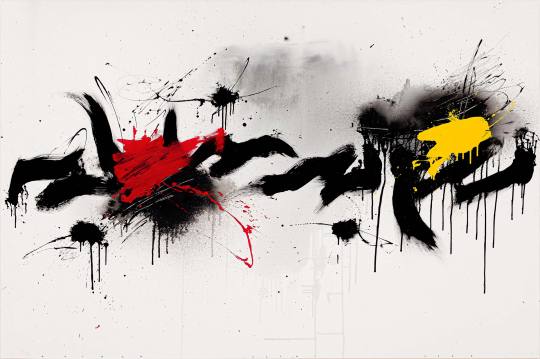
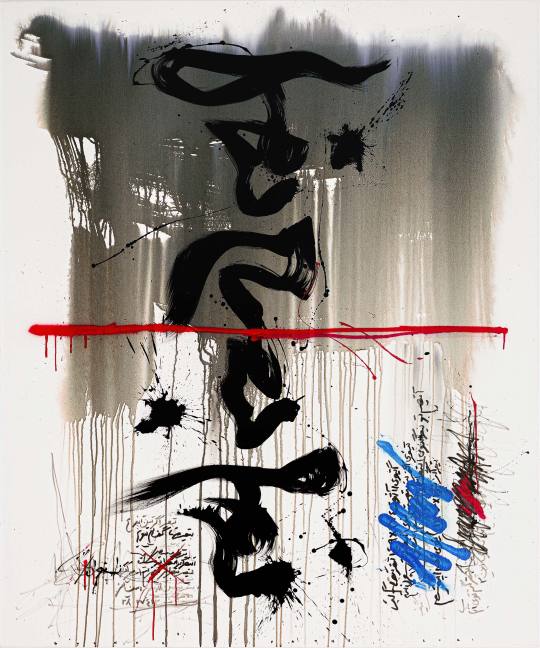

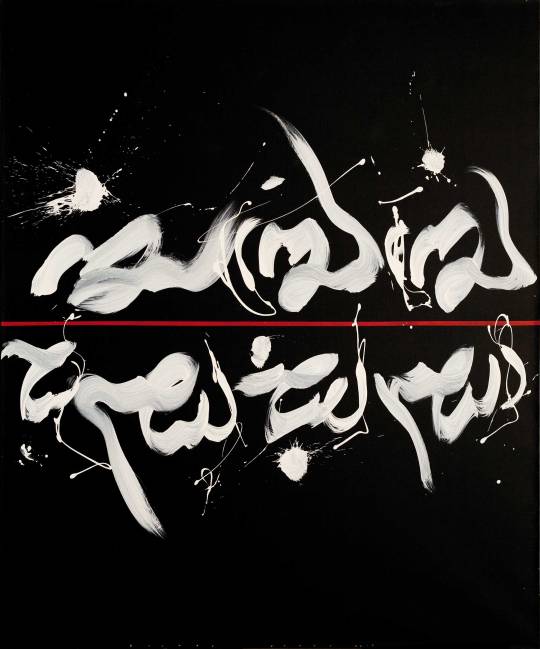
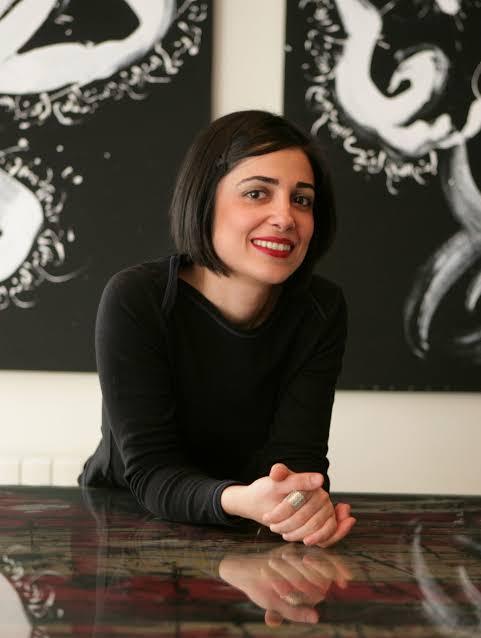
Born in 1972 in Tehran, Golnaz Fathi is a contemporary Iranian artist recognized for her reinterpretations of traditional Persian calligraphy. She studied graphic design at the Islamic Azad University and went on to study traditional Persian calligraphy, receiving a diploma from the Iranian Society of Calligraphy. She was named Best Woman Calligraphist by the Iranian Society of Calligraphy in 1995. She lives and works in Tehran.Fathi is widely recognized for expanding the tradition of calligraphy and pushing it to new heights.
Her works are inspired by American Abstract Expressionists and Iranian and Middle Eastern modernists, who pioneered the use of the written word as a pictorial element in the late 1950s and early 1960s. Technically brilliant, she has developed a new visual language, which reconciles the ancient with the contemporary. Fathi's interest in calligraphy derives from the medium's intention to match the visual beauty of a text with its content. Instead of communicating with words, she pushes the gestural qualities of calligraphy beyond language, into abstraction. Her works repeat forms, creating a meditative quality.
https://www.operagallery.com/artist/golnaz-fathi
178 notes
·
View notes
Text

Poster by Iranian graphic designer Moyamez, 1970s
8 notes
·
View notes
Text

So I was tryna figure out: how would the Younique staff fit into my little story?? Several of the characters have pretty cute looks, I didn’t wanna throw em away or make them terfs
well, solution!! For at least a couple of em, anyway.
reminder that TERFs literally CANNOT ALWAYS TELL that people are trans… they are so often wrong it is comical. A TERF bar could more than likely let in trans women without knowing or batting an eye… in my rewrite, Younique only profiled Ginger, Cherish, and Kaiya because they were so open and proud. Often why TERFs pick us trans folk out to begin with!! If you’re too proud, too open, too showy, they’ll try to take ya down. It sucks, but it’s why I’m so proud to be me. I’m so proud of my transgender siblings, because everyday we face the worst from society, and here we are, still standing.
I did change up Shanzay and Parniya’s styles quite abit… god, you can tell that there’s only *one* kind of lesbian Rusty thinks should exist. The diversity of women is a beautiful thing, and I wanted to show just how differently these two butch lesbians can present themselves, because there is more than one type of butch lesbian. (RUSTY.) People should dress how they’re comfortable, however the amount of characters were supposed to like who have the exact, plain style bothers me. People look different, even those within the same subcultures and similar presentations. I want to highlight that!!
Anyway, on to the character bios!!
Shanzay Binti Meriam!! Malaysian-Australian She/They, Transfeminine lesbian
Shanzay used to go to Younique with her girlfriend Parniya regularly, speaking with other regulars who took no issue with their trans identities. Shanzay is a confident woman who runs women’s martial arts classes with her girlfriend and her mother, Meriam. Unfortunately, after learning of the hateful incident at Younique regarding the GAP gang, Shanzay, Parniya, and several other regulars were horrified to learn of the hateful nature of a staff member of Younique. They took the issue to the owner, only to learn that this is standard behavior for the staff, and that a large majority of the staff are loud and proud transphobes. Shanzay and Parniya felt completely horrified that their less cis passing sisters went through this, not to mention that they had given their patronage to such a hateful business. They rallied many Younique regulars to take their leave, and to give their support to the GAP gang, giving their money to the PayPlease fund that would eventually help the girls open up GAP, their trans friendly nightclub. Shanzay now works for GAP as a bouncer, and is good friends with Kaiya particularly, bonding over their shared pride and love for their families.
Parniya Amira Gallus!! Iranian-Australian She/her, Transfeminine intersex lesbian
Standing at nearly 6’8, being transgender and intersex, and suffering from chemical burns at a young age, Parniya is not a very average looking woman. She is very quiet and mellow, and doesn’t wish to draw much attention to herself. Because of her wallflower nature, it’s no shock that the transphobic staff of Younique looked right past her and her girlfriend Shanzay whenever they walked in. Parniya identifies as a butch lesbian, though she still embraces her feminine side often. After finding out about Younique’s transphobia against the GAP gang, Parniya was particularly shaken. Even after rallying other regulars to leave with her and Shanzay, Parniya doesn’t go out nearly as often anymore. She wears much more makeup now, perhaps in an attempt to pass more, like she believes she will run into Younique staff again. Parniya does remote graphic design for GAP, and as a result is well acquainted with Theodosia, and has quickly become good friends with her. They bond over a shared love of old princess stories, as well as their passion for art and other women.
#angelicmelon#disabled artist#queer artist#trans artist#art#artists on tumblr#leasebound#autistic artist
13 notes
·
View notes
Text
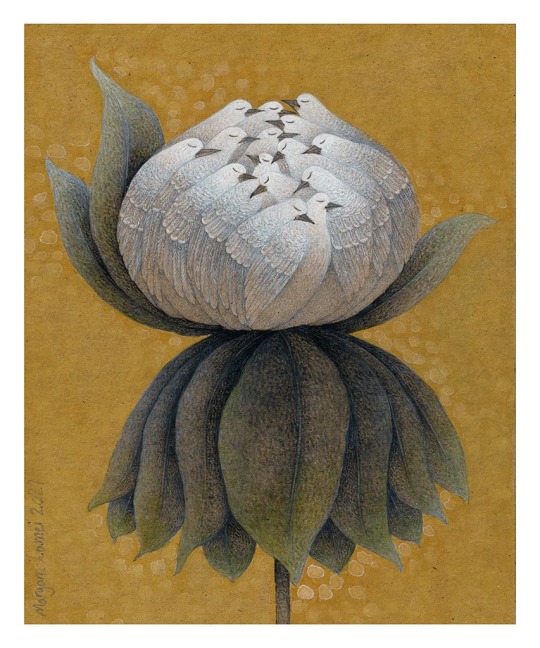
Maryam Lamei Harvani, Birds are gathered in God, 2021
Maryam Lamei Harvani was born in 1985 in Sarab, a historical city in northwest of Iran. After graduating in Graphic Design, she was awarded the National Art Prize and the art award from the Ministry of Science Research. Her work is inspired by the Iranian Golo Morgh (Flower and Bird) paintings, a traditional Persian way of painting in which the flower is the beloved and the bird is the lover. Via toiartgallery
22 notes
·
View notes
Text
Remember the nameless ones
Who survived the kiss of glacier
The years of lean and those of plenty
Whose genes slipped through pogroms
Who turned right instead of left
Whose soft, quick tongues made jokes of fate
Whose fingers shaped scraps into latkes
Who clung to their traditions, their songlines
Their medicine plants, their kinship
With Grandmother Earth, Grandfather Sky.
Blessed are the vanished ones
Whose habitat became expendable
Whose lives were extinguished by indifference
Whose pelts, horn and other body parts
Were worth more to those
Whose backs, walls and libidos they adorn
Those creeping, flying, swimming, leaping ones
Whose raucous calls, gauzy wings,
Webbed toes and gaudy hues
Will not be heard or seen again.
Give thanks to the myriad scavengers
Who scuttle and hover; who devour matter
Whose unseen industry tidies away death
Who rag-pick life from a mountain of leavings
Whose ingenuity fashions answers from decay
Whose webs and threads spin shrouds
Blessed are the wanderers who leave no trace
Who huddle under flyovers, in rotten wood
Who eat from skips and tips and gutters
Who sup from the kindness of strangers
Who sleep nightly under the infinite.
- Rachael Clyne

Artwork: "Birds are Gathered in God" (date unlisted) by MARYAM LAMEI HARVANI (Iranian, born 1985).
Acrylic on canvas
20 × 24
Maryam Lamei Harvani was born in Sarab, a historical city in Iran. After graduating in Graphic Design, she was awarded the National Art Prize and the art award from the Ministry of Science Research.
Her work is inspired by the Iranian Golo Morgh (Flower and Bird) paintings, a traditional Persian way of painting in which the flower is the beloved and the bird is the lover.”
#remember#life#heart and soul#art and soul#Rachael Clyne#birds are gathered in God#artwork#imagika#MARYAM LAMEI HARVANI
16 notes
·
View notes
Text
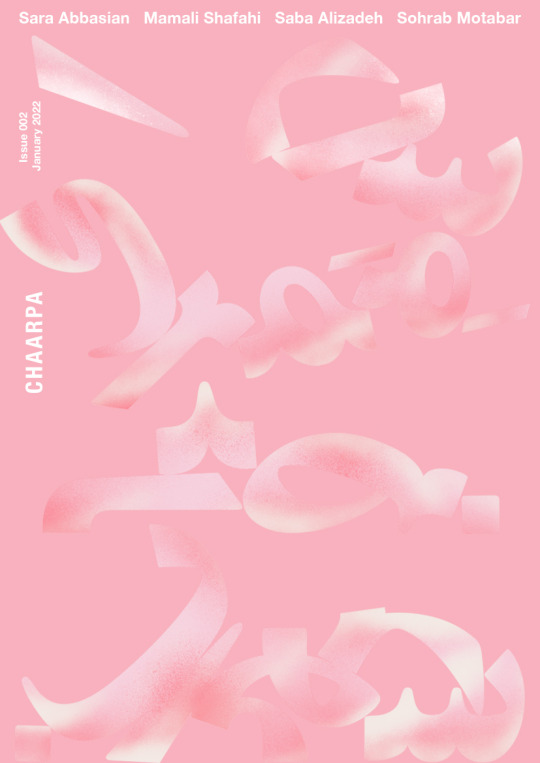
#POTK DESIGN#shahab tondar#chahab#typography#graphic design#persian typography#iranian graphic design#artwork
0 notes
Text


Sassanid helmet (6th-7th C. CE) & Luristan helmet (6th-9th C. BCE)
"The helmet housed at the Römisch Germanisches Museum in Mainz, Germany (Inv. O. 38823; Fig. 26) is dated to the late 6th-early 7th century CE. Discovered in Iran’s Amlash region, this helmet was built of bronze, silver and Iron. The Varanga “feather” (?) and/or “scale” pattern (?) is again evident as would be expected of late Sasanian helmets from the empire’s Western regions. The band enclosing the bottom area of the helmet is also decorated in the same Varanga/scale design. At the front of this area is a rectangle that has within it two vertical “sine wave” graphics. At the bottom edge of the rim can be seen punched holes, along with some cracks.
Unique in the case of this helmet is a crescent moon decoration like the one seen on Figure 25 cited previously. Atop the rectangle with the two “sine wave” designs on the helmet from Mainz is an upright crescent motif apparently based on a much earlier tradition; this is strikingly similar to the much more ancient 9th-7th century BCE one-piece domed bronze helmet (possibly Kassite in origin) excavated in Luristan (Fig. 26). At the back of the Luristan helmet is a repoussé hook and dot pattern, with a notched band of flecked triangles appearing along the border.38 The frontal decoration attached on this helmet consists of opposing mythological beast heads with a crescent ornament atop the figures. Interestingly, the Luristan helmet’s crescent motif appears in the same upright orientation as the Sasanian helmet suggesting a possible design motif spanning over 1000 years (Fig. 26)."
-Farrokh, K., Karamian, Gh., Kubic, A., & Oshterinani, M.T. (2017). An Examination of Parthian and Sasanian Military Helmets. In “Crowns, hats, turbans and helmets: Headgear in Iranian history volume I” (K. Maksymiuk & Gh. Karamian, Eds.), Siedlce University & Tehran Azad University, pp.121-163.
21 notes
·
View notes
Text
Journal Entry #7
ARTGR #520
From the onset, there has been a strong connection between our design and cultural semiotics course and the ongoing women's protest in Iran. Every aspect of this event has been intertwined with our course.
Firstly, On the 16th of September 2022, a 29-year-old woman named Mahsa Amini was reportedly murdered in Tehran by security forces while she was in custody for having an inappropriate hijab. Amani’s death sparked outrage and protests across Iran in cities like Tehran, Isfahan, and Tabriz, later spreading worldwide, with demonstrators demanding justice for her and ending police brutality and violence against women. The designs of protest posters, banners, and other visual materials play a crucial role in conveying the message of the protests. Using symbols, colors, and imagery can communicate powerful messages and ideas and reflect the cultural and historical context of the protests. For example, the hijab as a symbol of oppression and resistance is a common motif in protest art and design. Iran also gained international attention from this protest, with human rights organizations and activists worldwide expressing solidarity with the protesters and condemning the Iranian government's response. Even the United Nations also called for an investigation into Amani’s death and urged the Iranian government to ensure accountability for the perpetrators. Many human rights organizations, including Amnesty International and Human Rights Watch, condemned the Iranian government's response to the protests and called for an independent investigation into Amani’s death. These organizations also expressed concern about the broader issues of police violence and discrimination against women in Iran. Without the use of posters, animations, and prompts to spread the message to the world, none of these events would have occurred. Upon reading about the Madame Binh Graphics Collective (MBGC), I came to the realization of integrating graphic design into a larger ethical framework that encompasses concepts like allyship and privilege as a means to achieve revolutionary goals.
The protests in Iran also highlighted long-standing issues of police brutality and violence against women. Women in Iran have long faced discriminatory laws and practices, including mandatory hijab laws, which they have protested in the past. The protests after Amani’s death are part of a broader movement for greater gender equality and human rights in Iran.
Also, cultural semiotics did help me to understand the deeper cultural and social meanings behind the women's protests in Iran. The hijab, for example, is not just a piece of clothing but is also deeply embedded in Iranian culture and history. By protesting against the compulsory hijab, Iranian women challenge traditional cultural norms and assert their right to self-expression and individual freedom. Understanding the cultural and historical context of the hijab and its symbolic significance is essential for understanding the meaning and significance of the protests.
The international support for the protesters in Iran highlights the growing awareness of human rights issues in the country and the importance of solidarity and collective action in promoting greater freedom and justice for all.
Finally, design and cultural semiotics shed light on the power dynamics in the women's protests in Iran. By analyzing the visual language and symbolism of the protests, we can see how different groups and individuals are positioning themselves toward each other. For example, using the hijab as a symbol of resistance can be seen as a challenge to the authority of the Iranian government and the conservative clerical establishment. Understanding these power dynamics is essential for understanding the protests' broader social and political context.
2 notes
·
View notes
Text
The influence of and connection to Islamic art

Aloma Treister doesn’t remember much of her childhood. She recalls being taught Arabic at school and the fact that her family’s social life revolved around their immediate family.
“Our closest friends were our cousins,” she told The Australian Jewish News. It was how many Jewish families in the Middle East grew up – all related to each other and all friends. One big community.
Treister was born in Baghdad and explains that she was named after the film Aloma of the South. Her mother was pregnant when she saw it and immediately decided that if she had a girl, she would name her Aloma.
Treister explained that her family saw the writing on the wall before the Farhud – the outbreak of mob violence against the Jews in 1941, often described as a turning point for the history of Jews in Iraq. While some of her extended family fled Iraq for Israel, her family stayed behind.
“Although many Iraqi Jews began emigrating to Israel, my father decided not to because by that stage he was over fifty and not easily employed,” Treister explained. “We headed to Iran because my father had cousins there and obtained Iranian passports, perhaps forged.
There were four of us: my mother, my father, my brother and I. But the passports were for two boys and a girl. I remember my father and my mother wearing black, pretending their ‘third’ child had died and they were in mourning.”
After a few months, Treister, her brother and her mother headed to Israel where she embraced her artistic side.
“I’ve always loved art and painted from an early age. When I lived in Israel, I worked as a graphic designer at the television station,” she said.
“Visual art, like writing, is a lonely profession. You must be totally dedicated. It can be very frustrating and exasperating, but also very rewarding. You don’t become an artist thinking that it will be financially rewarding, making art is the reward.”
When she did her master’s degree in art, Treister spoke about how her Iraqi heritage influenced her art, particularly Islamic art.
“Since both religions are averse to figurative representation, Islamic art was easily adopted and became part of Jewish art and life,” she explained, saying a ketubah could easily be mistaken for a Persian miniature, and in the Middle East, synagogues were intricately decorated with mosaic mirror tiles in recognisable Islamic patterns.
Throughout the years she went back and forth between Israel and Iran, with a stint also in England, where she met her husband.
He was only in the UK for three weeks but during his time there they became good friends, and when he went to Iran, Treister gave him her family’s address.
“They invited him for dinner, and he met not only with my family but also with Iraqi Jews who had just escaped Baghdad. This contact opened his eyes and was his first contact with Sephardi Jews,” she wrote.
Eventually, the pair moved to Australia, where Treister said her art moved through several different stages.
“The subject of my master’s thesis was ‘Jewish Heritage, Islamic culture’,” she explained.
“Quite a number of my art works were based on old Jewish/Iraqi photographs taken from a magazine called The Scribe, a Jewish Iraqi magazine which was published in London, and Islamic designs.
I borrowed the images that were meaningful to me. I worked on them, changed them, and added to them, until they became meaningful to me.”
Islamic design is central to a lot of Treister’s art.
“We grew up with Islamic design all around us. Middle East Jews appropriated these elements of design because they were not representational, and could be used in synagogues and in the homes,” she said.
“The Jews who came from Europe may have had Chagall paintings hanging on their walls; we hung carpets.”
The artist has had several exhibitions in Melbourne, interstate and overseas, and has been awarded prizes and grants for her works.
She also illustrated primary readers for Beth Rivkah Ladies College in Melbourne and recently published and illustrated a children’s book called A Home for Zac. It’s based on a story her son wrote when he was younger.
While she calls Australia home, she said she understands that her identity is fluid, often influenced by her connection to Iraq, Iran and Islamic culture.
As she wrote in her master’s thesis, “In the process of relocation, I rethink my connection to my roots.
The culture I belonged to is no longer a physical reality; it is not exclusive to a particular place but it is alive in my consciousness; it exists in my imagination, in my desires. It is formed out of abstraction and fantasies.
In relocating I disconnect my culture from its past roots, and re-figure it to satisfy my need within this culture … My original culture has not declined, but has reinvented and reconfigured itself in my imagination and through my art work. A new form of cultural expression has emerged.”
Indeed, it’s very much reflected in her beautiful and unique art.
#iraq#manchester#uk#iraqi#baghdad#liverpool#scotland#usa#london#art history#artwork#artists on tumblr#australia#europe#world history
1 note
·
View note
Text

SR-71 Pilot tells why the only SAM that had a chance to hit the Blackbird was a Nuclear S-300 fired ahead of the Habu
The Blackbird
The SR-71, unofficially known as the “Blackbird,” is a long-range, advanced, strategic reconnaissance aircraft developed from the Lockheed A-12 and YF-12A aircraft. The first flight of an SR-71 took place on Dec. 22, 1964, and the first SR-71 to enter service was delivered to the 4200th (later 9th) Strategic Reconnaissance Wing at Beale Air Force Base, Calif., in January 1966.

CLICK HERE to see The Aviation Geek Club contributor Linda Sheffield’s T-shirt designs! Linda has a personal relationship with the SR-71 because her father Butch Sheffield flew the Blackbird from test flight in 1965 until 1973. Butch’s Granddaughter’s Lisa Burroughs and Susan Miller are graphic designers. They designed most of the merchandise that is for sale on Threadless. A percentage of the profits go to Flight Test Museum at Edwards Air Force Base. This nonprofit charity is personal to the Sheffield family because they are raising money to house SR-71, #955. This was the first Blackbird that Butch Sheffield flew on Oct. 4, 1965.
During its operational lifetime, the SR-71 provided intelligence about the Yom Kippur War in 1973, the Israeli invasion of Lebanon in 1982, the US raid on Libya in 1986 and the revelation of Iranian Silkworm missile batteries in 1987. The USAF ceased SR-71 operations in January 1990.
The Blackbird was designed to operate at extreme velocities and altitudes: in fact, from 80,000 feet, it could survey 100,000 square miles of Earth’s surface per hour. Achieving a radar lock on it was extremely difficult not only for any fighter jet then in service, but also for any surface-to-air (SAM) missile.
45 degrees of bank for a designated high bank turn
Thus, the rumors that the SR-71 stopped flying because it could be intercepted by jet fighters then in service with neutral countries in the Baltic or by Soviet MiGs are not true. There were so many factors in place to protect the Blackbird from being fired upon, some of which cannot be discussed in detail as they are still classified.
artwork

This print is available in multiple sizes from AircraftProfilePrints.com – CLICK HERE TO GET YOURS. Dawn at 80.000ft – SR-71 Blackbird
Former SR-71 pilot David Peters confirms this statement;
‘We were allowed 45 degrees of bank for a designated high bank turn. Radius is about 60 miles at 3.2. But your change of heading is pretty rapid you are just covering a lot of ground and air doing it. Most people don’t understand the dynamics. We were not going to outmaneuver much of anything. What matters is the proximity to start with. The speed and range of the protagonist.
‘One of the real highlights of flying above Mach 3 and above 80,000 feet is nobody is up there with you. They have to see you (radar) first. How far away is significant because we are not just larking along.
‘If you are talking surface-to-air missiles, how long does it take to launch get to 80,000 feet? How long does it take, and how close does it have to get to be able to maneuver if we are not going straight ahead?
‘Very few missiles could go far enough to make up 36 or more miles per minute.
‘All this is not taking any consideration of our ECM capability.’
SR-71 Pilot tells why the only SAM that had a chance to hit the Blackbird was a Nuclear S-300 fired ahead of the Habu
S-300 SAMs
A Nuclear S-300 fired ahead of the SR-71
Peters concludes;
‘The bottom line is the only surface-to-air missile that had any chance at all was the SA-10 [SA-10 Grumble, the NATO reporting name of the S-300 Soviet SAM system] if it was nuclear. That would allow them to fire it out ahead of us with an air burst at altitude, which we could possibly not circumvent. Airborne I.e. interceptors none had any chance what so ever.’
Be sure to check out Linda Sheffield Miller (Col Richard (Butch) Sheffield’s daughter, Col. Sheffield was an SR-71 Reconnaissance Systems Officer) Twitter X Page Habubrats SR-71, Instagram Page SR71Habubrats and Facebook Page Born into the Wilde Blue Yonder Habubrats for awesome Blackbird’s photos and stories.
@Habubrats71 via X
8 notes
·
View notes
Text



















Arghavan Khosravi arghavankhosravi.com
Arghavan Khosravi (b. 1984, Shahr-e Kord, Iran), lives and works in Stamford, Connecticut.
Khosravi’s studio practice mobilizes visual art as a vehicle for cultural transformation. She investigate the aesthetics of ancient Persian miniature paintings, which were originally used to illustrate folkloric texts. Typically, the only women they portray have a subservient or secondary role, lacking agency and social significance. Khosravi’s paintings take a conscious look at how the value system transmitted by that iconography continues to shape Iranian gender politics today. The most noticeable visual characteristic of Khosravi’s paintings is their multi-dimensionality. Constructed from a complex scaffolding of cut and painted wooden panels, they offer a constantly shifting perceptual experience. Visual motifs such as black plumes, rockets, and cages reference corrupted economic and political systems, while female bodies are often depicted as being shackled or with their mouths sewn shut.
Arghavan Khosravi earned an MFA in painting from the Rhode Island School of Design after completing the studio art program at Brandeis University. Khosravi previously earned a BFA in Graphic Design from Tehran Azad University and an MFA in Illustration from the University of Tehran.
0 notes